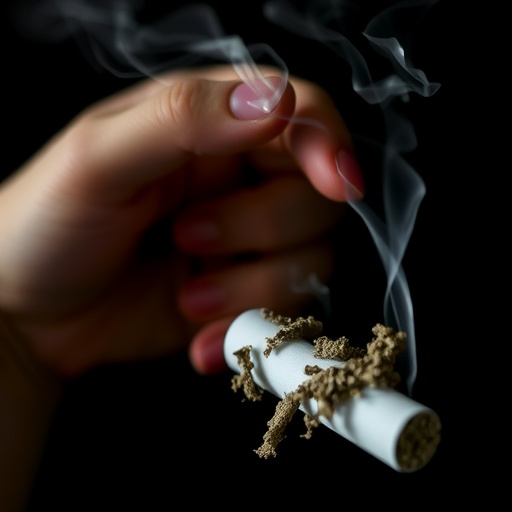A groundbreaking study led by Dr. Ashley Merianos, a professor of human services at the University of Cincinnati specializing in tobacco research, uncovers a significant linkage between adverse childhood experiences (ACEs) and elevated exposure to tobacco smoke among school-aged children in the United States. This research, recently published in the esteemed journal Child Protection and Practice, suggests that children subjected to trauma, including parental divorce, neighborhood violence, or economic hardship, face not only direct psychological harm but also increased physical health risks from living in households with tobacco use.
Dr. Merianos and her team employed a rigorous meta-analytical methodology, synthesizing extensive datasets to elucidate how escalating numbers of adverse childhood experiences correspond to heightened probabilities that affected children reside with tobacco users. The implications here extend beyond commonplace assumptions, revealing a nuanced interplay between psychosocial stressors and environmental health determinants. These findings highlight a critical intersection where trauma and tobacco exposure converge to compromise child development and public health.
One of the study’s most striking revelations concerns the multifaceted nature of tobacco smoke exposure. While secondhand smoke is widely recognized as harmful, this research draws attention to the insidious threat of thirdhand smoke—tobacco residues that linger long after active smoking has ceased. Surfaces such as furniture, walls, and clothing can harbor toxic substances that children may ingest, inhale, or absorb dermally. Alarmingly, even children whose caregivers only smoke outdoors are not insulated from these dangers, challenging prevailing misconceptions about safe smoking practices within domiciles.
Epidemiological evidence from the study underscores that ACEs do not merely predispose children to psychological adversities but also to environmental hazards that can potentiate chronic illnesses, including respiratory diseases and even carcinogenesis. The physiological burden imposed by toxicants in tobacco smoke and its residues can exacerbate vulnerabilities created by trauma, potentially leading to compounded negative health trajectories in affected youth populations.
Dr. Merianos, an affiliate of the Thirdhand Smoke Research Consortium, leverages over a decade of expertise focused on the confluence of tobacco use and childhood development to frame this research within the broader context of preventive medicine and social policy. Through collaborations with institutions like Cincinnati Children’s Hospital, her prior investigations revealed pervasive thirdhand smoke contamination in domestic environments, identifying nicotine deposits and carcinogenic compounds ubiquitously within homes harboring children.
The present study’s policy implications are profound. Recognizing ACEs as potential root causes for living in tobacco-smoking households illuminates new avenues for trauma-informed intervention strategies. Integrative approaches that concurrently address childhood adversity and environmental toxin exposure are paramount. Public health stakeholders must recalibrate tobacco control policies to incorporate mental health and social welfare perspectives, fostering protective environments that mitigate both psychological and toxic environmental risk factors.
From a technical standpoint, the meta-analysis distilled data across various cohorts to quantify exposure differentials linked to specific categories of adversity, including familial discord and community violence. The stratification of data enabled researchers to discern not only prevalence rates but also the gradation of exposure intensity relative to ACE severity. This analytical granularity affords a compelling evidence base to justify targeted resource allocation and tailored health promotion efforts.
Furthermore, the study elucidates ongoing challenges in eliminating thirdhand smoke exposure, as current public health messaging has inadequately addressed its risks. Chemical persistence on indoor surfaces and fabrics necessitates comprehensive educational campaigns highlighting the latent hazards beyond active smoking episodes. Toxicological pathways through which thirdhand smoke constituents induce cellular damage, ranging from oxidative stress to DNA mutations, demand heightened scientific and regulatory attention.
This research accentuates an urgent call to action for integrative healthcare providers, educators, and policymakers. Interventions at the intersection of trauma mitigation and tobacco exposure reduction could encompass home environment assessments, caregiver support programs, and community-level violence prevention, synergizing efforts to break the cascading chain of risk. Ultimately, these strategies aspire to safeguard children’s holistic health and foster resilient trajectories free from the compounded burdens of trauma and toxic exposures.
In sum, Dr. Merianos’ study represents a pivotal advance in understanding the interface between psychosocial adversity and environmental health hazards among vulnerable U.S. children. It challenges entrenched myths about safe tobacco use and illuminates the hidden perils faced by millions of youth living under the shadow of both trauma and tobacco smoke pollution. The findings advocate for an expanded vision of public health that integrates trauma-informed care models with aggressive tobacco control measures to ultimately protect and empower future generations.
Subject of Research: People
Article Title: Adverse childhood experiences and tobacco smoke exposure among U.S. school-aged children
News Publication Date: 12-Jul-2025
Web References:
https://www.sciencedirect.com/science/article/pii/S2950193825001184
Image Credits: University of Cincinnati/Marketing + Brand
Keywords:
Human health, Environmental health, Health care, Health and medicine




